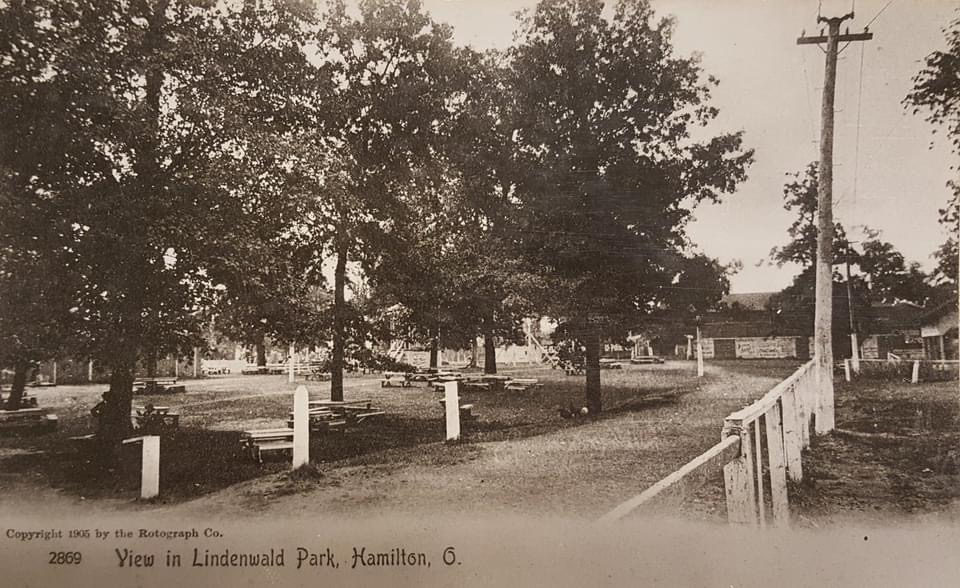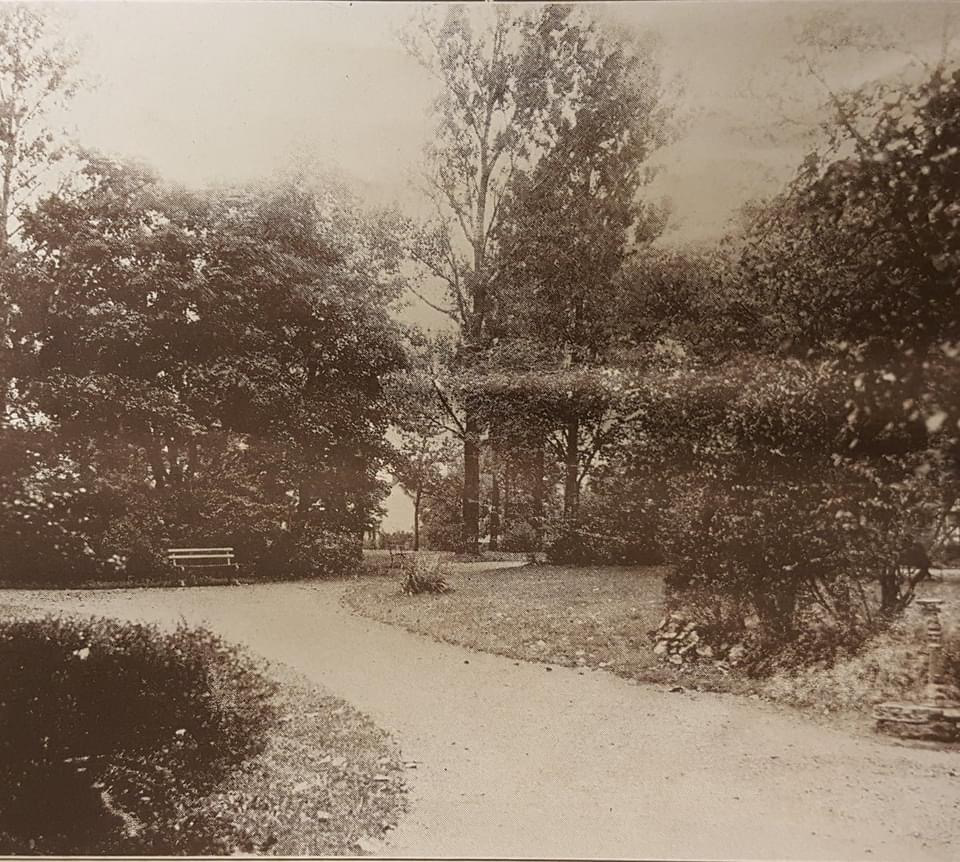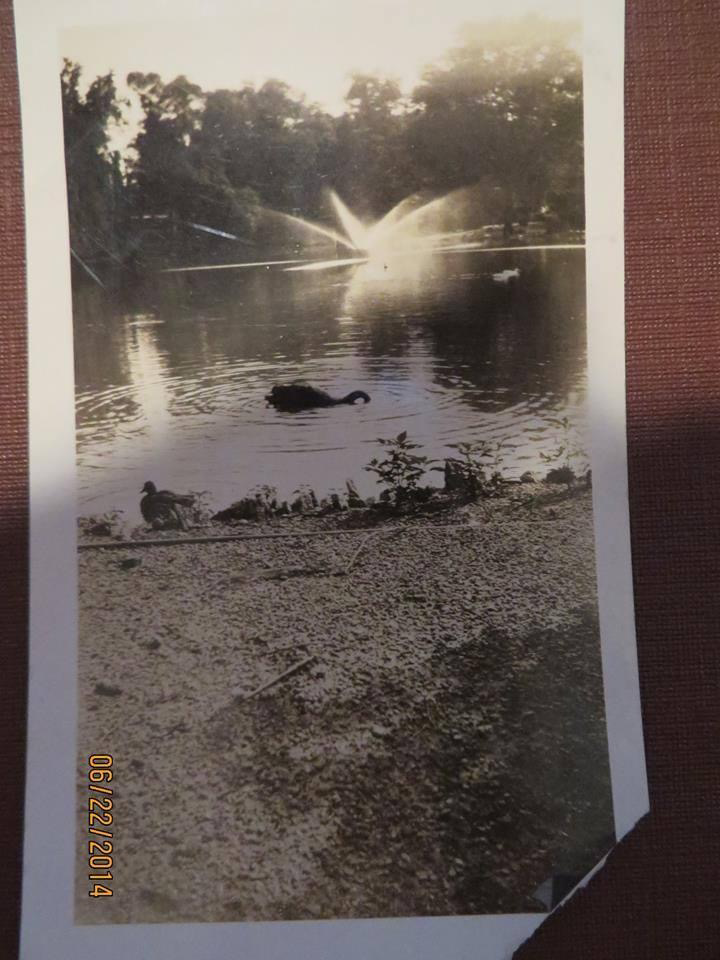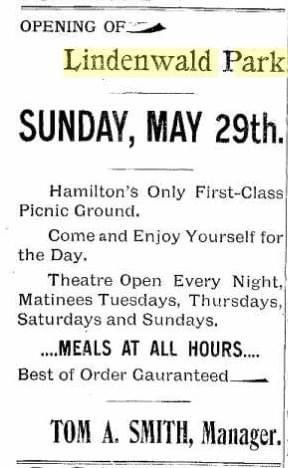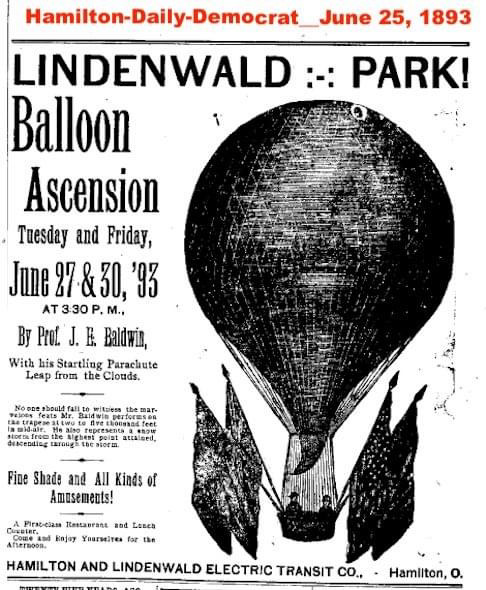Lindenwald Amusement Park
Lindenwald Amusement Park__Revisited
Lindenwald Amusement Park opened in 1888. After 'on and off again' financial difficulties the park permanently closed around 1913. Although it was located in Lindenwald, it was billed as Hamilton's first and only amusement park. From north to south, it was located between Laurel Avenue and the alleys between Hooven and Minor Avenues. From east to west , it was located between Zimmerman Avenue and Benninghofen Avenue.
The main entrance was where Benninghofen Avenue dead ends (at the time) at Laurel Avenue. The electric trolley car railway completed May 1892 ran down Benninghofen Avenue transporting visitors into the park. Today the current Lindenwald Park at Benninghofen and Minor Avenues is a small remnant of the original park. It is unknown were the various park features including the ball field were located within the park. It is believed the large pond was located at the east end of the park toward Zimmerman Avenue.
The Lindenwald Amusement Park or simply called Lindenwald Park, ranged over approximately 22 acres of land. The park featured a large pond, a bike path, rides for the toddlers including a small roller coaster and merry-go-round, a dance pavilion, an indoor opera house (used mostly during adverse weather), clubhouse and a 2000-seat open air theater for various types of entertainment such as Vaudeville Theatrics, Comic Operas, Orchestra Concerts and other Theatrical performances. The Park had a full time manager and seasonal employees.
During the day entrance to the Park was free. A 10¢ fee was charged after 7:00 p.m. Fees were also charged for meals (served in the clubhouse), entertainment performances and concessions. A small fee is also believed to have been charged to attend baseball games.
The baseball field with bleacher seating for large attendance adjoined the park. Baseball was a major attraction to Lindenwald Park which included semi-pro league games, generally industrial leagues pitted against teams from other cities and occasional minor league affiliated teams. Lindenwald Park was also home to the popular baseball team, the Hamilton Krebs (Krebs Clothing), a semi-pro team.
The park also hosted an occasional exhibition game between the Cincinnati Reds and a local industrial league team such as the semi-pro teams, the Hamilton Browns or the Hamilton Clippers, a minor league affiliate. On July 26, 1894, the Hamilton Browns played the Cincinnati Reds and lost 15-1. At least they were not shutout. The City of Hamilton once hosted a game between the Cincinnati Reds and the Brooklyn Dodgers at High Street & Fair Avenue.
Lindenwald Park also featured covered shelters, concessions, gazebos and picnic grounds throughout the park. Lindenwald Park has been documented in a book titled "Hamilton, Postcard History Series". In addition, Lindenwald Park has been listed in the "1901-1902 Julius Cann's Official Theatrical Guide" and in the June 9, 1900 issue of "The Billboard" magazine under "Parks, Pleasure Resorts, Summer Gardens".
Lindenwald Amusement Park opened in 1888. After 'on and off again' financial difficulties the park permanently closed around 1913. Although it was located in Lindenwald, it was billed as Hamilton's first and only amusement park. From north to south, it was located between Laurel Avenue and the alleys between Hooven and Minor Avenues. From east to west , it was located between Zimmerman Avenue and Benninghofen Avenue.
The main entrance was where Benninghofen Avenue dead ends (at the time) at Laurel Avenue. The electric trolley car railway completed May 1892 ran down Benninghofen Avenue transporting visitors into the park. Today the current Lindenwald Park at Benninghofen and Minor Avenues is a small remnant of the original park. It is unknown were the various park features including the ball field were located within the park. It is believed the large pond was located at the east end of the park toward Zimmerman Avenue.
The Lindenwald Amusement Park or simply called Lindenwald Park, ranged over approximately 22 acres of land. The park featured a large pond, a bike path, rides for the toddlers including a small roller coaster and merry-go-round, a dance pavilion, an indoor opera house (used mostly during adverse weather), clubhouse and a 2000-seat open air theater for various types of entertainment such as Vaudeville Theatrics, Comic Operas, Orchestra Concerts and other Theatrical performances. The Park had a full time manager and seasonal employees.
During the day entrance to the Park was free. A 10¢ fee was charged after 7:00 p.m. Fees were also charged for meals (served in the clubhouse), entertainment performances and concessions. A small fee is also believed to have been charged to attend baseball games.
The baseball field with bleacher seating for large attendance adjoined the park. Baseball was a major attraction to Lindenwald Park which included semi-pro league games, generally industrial leagues pitted against teams from other cities and occasional minor league affiliated teams. Lindenwald Park was also home to the popular baseball team, the Hamilton Krebs (Krebs Clothing), a semi-pro team.
The park also hosted an occasional exhibition game between the Cincinnati Reds and a local industrial league team such as the semi-pro teams, the Hamilton Browns or the Hamilton Clippers, a minor league affiliate. On July 26, 1894, the Hamilton Browns played the Cincinnati Reds and lost 15-1. At least they were not shutout. The City of Hamilton once hosted a game between the Cincinnati Reds and the Brooklyn Dodgers at High Street & Fair Avenue.
Lindenwald Park also featured covered shelters, concessions, gazebos and picnic grounds throughout the park. Lindenwald Park has been documented in a book titled "Hamilton, Postcard History Series". In addition, Lindenwald Park has been listed in the "1901-1902 Julius Cann's Official Theatrical Guide" and in the June 9, 1900 issue of "The Billboard" magazine under "Parks, Pleasure Resorts, Summer Gardens".
Lindenwald Amusement Park overlay of the area it consumed in the late 1800s and early 1900s with current 2020 map of the area. This area is equivalent to approximately 9 city blocks vs the single block for the current leftover portion of the park.
A 1895 map section showing the location of Lindenwald Park below Laurel Ave. between the railroad or Zimmerman Ave. and Benninghofen Ave.
Grand advertisement for Lindenwald Amusement Park from Hamilton newspaper dated July 2, 1898 listing more about the park including Park Theatre, park clubhouse, park features, etc.
This is an ad from a Hamilton Newspaper dated Aug. 23, 1894 for show appearing at the Lindenwald Park with orchestra entertainment.
Aug. 1, 1903 newspaper ad promoting a vaudeville performance at Lindenwald Park.
This ad is from Aug. 16, 1894 edition of the Hamilton Daily Republican newspaper.
Newspaper advertisement dated May 30, 1898 regarding the season opening of Lindenwald Park with the theater open every night.
1906 photo of the Hamilton Kreb's baseball team at Lindenwald Park. Joyce Junkin Cockerill's grandfather Benno Reeb played with the Krebs during this period. Are any of the players listed related to readers of "Memories of Lindenwald"?
Advertisement dated Sept. 20, 1894 from a Hamilton Newspaper featuring the industrial league baseball team, the Hamilton Browns.
This is another advertisement dated June 25, 1895. This ad lists the starting lineups. Anyone know of or related to a listed player for the Browns?
Various banner type ads promoting events at Lindenwald Park. Click on the picture to read the comments under each banner ad.
Another event held at the Lindenwald park with parachute jump.
Found this formal invitation circa 1894 to an evening of dancing at Lindenwald Park with music provided by Wolf's Full Orchestra.



